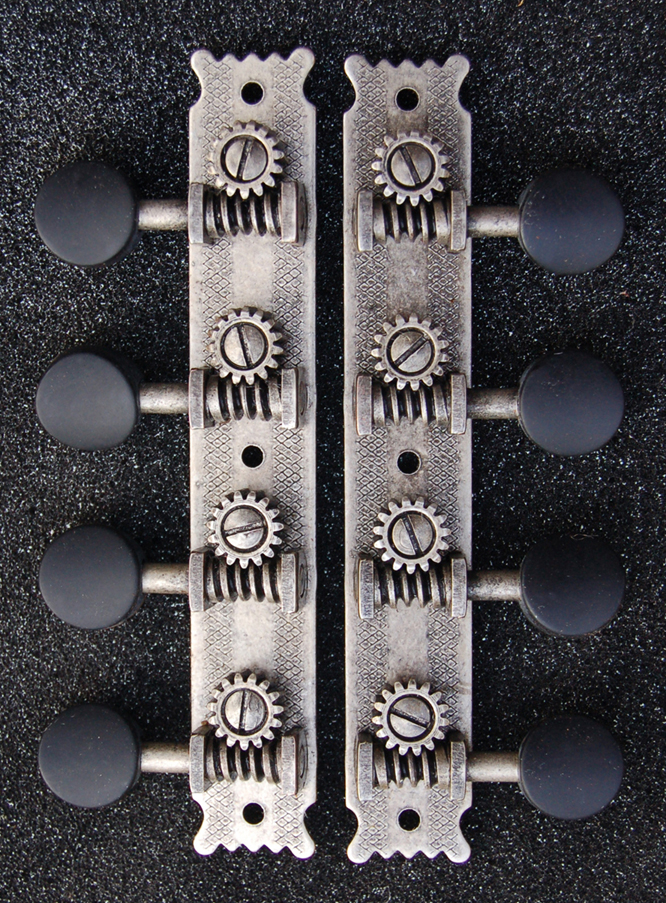Views: 1018
Replies to This Discussion
-
First of all, why "swap out" the old tuners? What's wrong with them? Before you do anything rash, check this: http://www.lutherie.net/tuner.maintenance.html
The Stew-Mac tuners are excellent, but they really only take the buttons made for those shafts. (They were initially offered with black buttons, I believe I have a set or two—not sure what happened to that option.) The buttons they now come with are glued on with CA and are otherwise not much like any other tuners on the market. I could take some photos, but it suffices to say the buttons match the rather clever machining of the shaft. Of the two buttons now offered, the ivoroid ones can be artificially aged, darkened with leather dye, if you're careful. The ivoroid itself looks pretty nice though, and of the two button choices it's the more durable and stable.
Old Gibsons like yours never had black buttons in the first place. Black buttons usually came on much later (and cheaper) instruments. The Arnold video shows the removal of plastic buttons on Kluson machines. They're not what you'd find on an old Gibson.
-
First of all, why "swap out" the old tuners? What's wrong with them? Before you do anything rash, check this:http://www.lutherie.net/tuner.maintenance.html
The Stew-Mac tuners are excellent, but they really only take the buttons made for those shafts. (They were initially offered with black buttons, I believe I have a set or two—not sure what happened to that option.) The buttons they now come with are glued on with CA and are otherwise not much like any other tuners on the market. I could take some photos, but it suffices to say the buttons match the rather clever machining of the shaft. Of the two buttons now offered, the ivoroid ones can be artificially aged, darkened with leather dye, if you're careful. The ivoroid itself looks pretty nice though, and of the two button choices it's the more durable and stable.
Old Gibsons like yours never had black buttons in the first place. Black buttons usually came on much later (and cheaper) instruments. The Arnold video shows the removal of plastic buttons on Kluson machines. They're not what you'd find on an old Gibson.
Thanks, Paul for your comments. I appreciate the useful information. How the buttons are secured and what the shaft looks like once they're removed is exactly what I needed to know.My mandolin is just a simple A-model (no headstock inlay, minimal trim), and came to me in less than original condition. It's destined to be a player's instrument rather than a restored vintage specimen, so the fact that black buttons were not stock in 1920 isn't an issue for me.
I had seen your tuner maintenance page, and was planning to give mine a cleanup in any case, but I wanted the higher gear ratio in the replica tuners and thought I'd see if I couldn't get some with black buttons, which I prefer, at the same time. If you still have a set with black buttons, would you be interested in parting with it?
The idea of staining the ivoroid buttons with leather dye is an excellent alternative strategy. The top on this A-model is Sheraton brown, and even if the buttons didn't stain completely black they might complement the top well. Is there a particular brand and color of dye you'd recommend, and how would you go about staining them?
Thanks again for the insights and advice!
Jim
-
Jim -
I don't have a set anymore, but here’s evidence they did once exist:
Try calling (not emailing) Stew-Mac and ask them if you can get some with the black buttons. Just because they're not in the catalog doesn't mean they're not on a shelf somewhere. It's worth a call.
I think increased gear ratio is overrated. The old Waverly machines tune beautifully if they're maintained well.
I use Fiebing's and Angelus leather dyes (not oil based!) to dye ivoroid, and dip them and shake off the extra so an even coating can dry slowly. It's usually to tint it so it looks old. I rather doubt getting a darker color is feasible, but the amber dip turns out to penetrate and hold up quite well under normal use.
-
Thanks for your help, Paul. I called StewMac and they confirmed, alas, that they did not have any more tuners with the black buttons, but I might give the leather dye process a try.
Cheers,
Jim
© 2025 Created by Frank Ford.
Powered by
![]()
